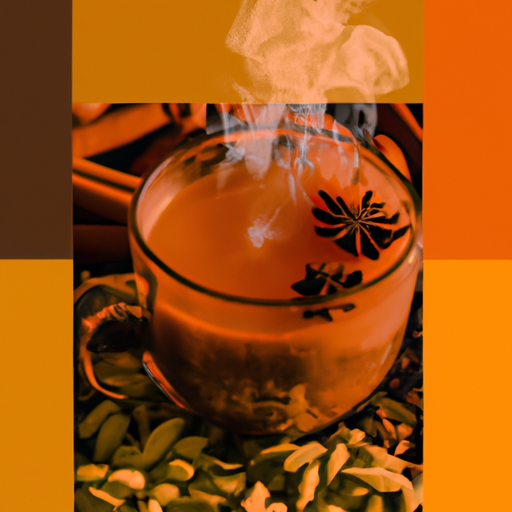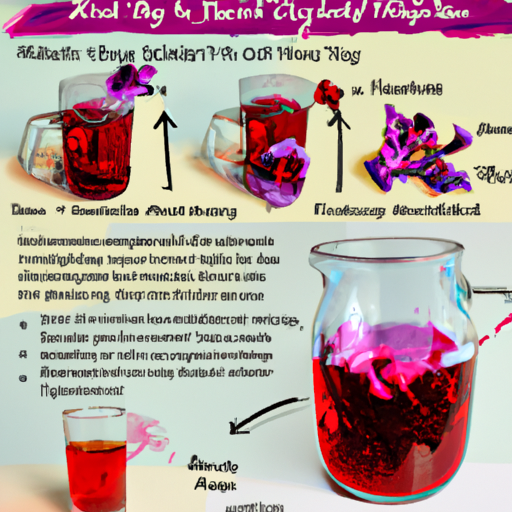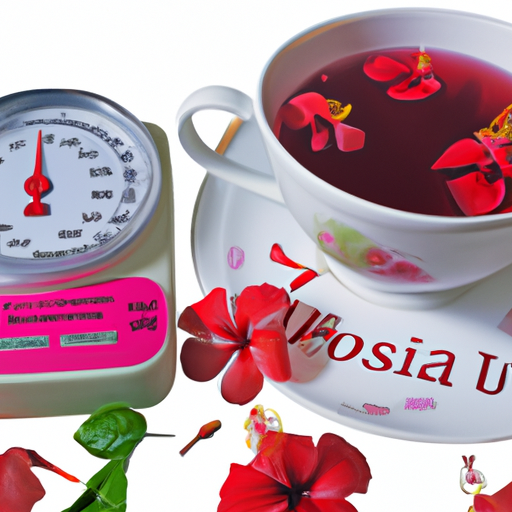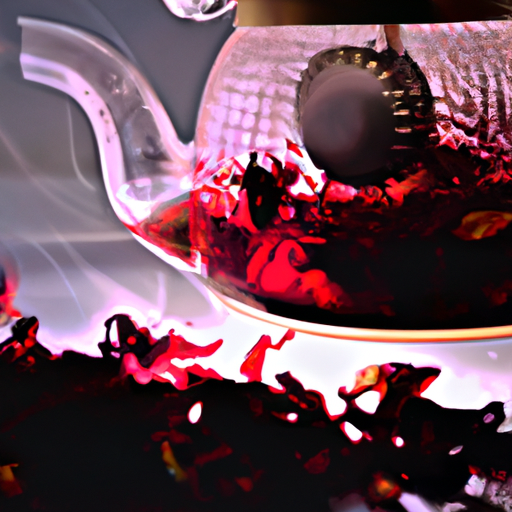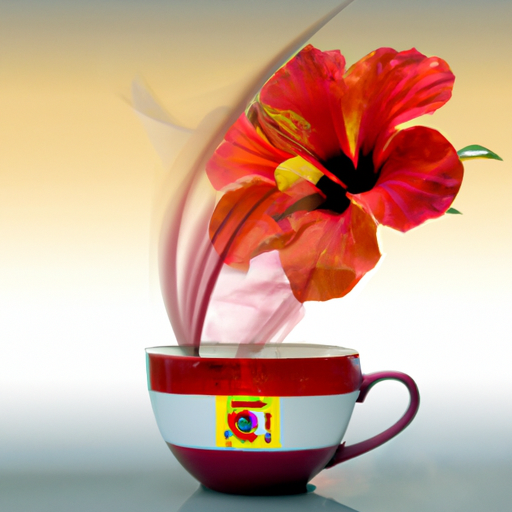Being health-aware and always in search of nutritional drinks, I took an interest in the calorie count of hibiscus tea. Known globally for its delightful flavor and myriad of health advantages, hibiscus tea has gained considerable popularity lately. It’s becoming a staple in the daily lives of many who seek a healthier substitute for beverages high in sugar.
In this article, I will explore how many calories are present in hibiscus tea, the nutritional value of this beverage, and factors affecting its caloric content. Additionally, I will discuss some of the potential risks and side effects associated with consuming hibiscus tea and provide instructions on how to make it at home.
Whether you’re already a fan of hibiscus tea or just interested in learning more about this delicious beverage, read on to discover all you need to know about its calorie count!
Key Takeaways
- Hibiscus tea is low in calories and macronutrients.
- The caloric content can be affected by preparation and additives.
- It is important to watch calorie intake when adding sweeteners.
- The potential health benefits of hibiscus tea include improved heart health, hydration, and increased antioxidant intake, but more research is needed to confirm its potential benefits on liver function and inflammation reduction.
What is Hibiscus Tea?
Hibiscus tea’s tart and floral flavor profile, along with its potential health benefits, make it a popular beverage choice. This tea is made from the dried petals of the hibiscus flower, which is native to subtropical and tropical regions around the world.
History shows that hibiscus tea has been consumed for centuries in various cultures for both medicinal and culinary purposes. In many cultures, hibiscus tea holds significant cultural importance. For example, in Egypt, it was believed to enhance beauty and youthfulness. In Mexico, it’s commonly consumed as a refreshing drink during hot weather. Hibiscus tea is also known as ‘sour tea’ in Iran and is served cold during hot summers.
The popularity of hibiscus tea continues to grow due to its unique taste and potential health benefits. It’s an excellent source of antioxidants that can help protect against cellular damage caused by free radicals. Additionally, studies show that drinking hibiscus tea may lower blood pressure levels and reduce cholesterol levels in people with high blood pressure or diabetes.
Moving on to the nutritional value of this beverage…
The Nutritional Value of Hibiscus Tea
As I’m exploring hibiscus tea, I’m curious about its nutritional value. I want to know the number of calories in each serving and which macronutrients it contains. Also, I’m interested in learning about the vitamins and minerals present in this refreshing drink.
Additionally, I am interested in learning about the vitamins and minerals that can be found in this refreshing beverage.
Calories and Macronutrients
You’ll be happy to know that a serving of hibiscus tea contains very few calories and almost no macronutrients, making it a guilt-free beverage option. For those who are calorie tracking or diet planning, one cup of hibiscus tea (240 ml) has only 2-5 calories. This makes it an excellent alternative to high-calorie drinks such as soda or juice.
In addition to being low in calories, hibiscus tea is also low in macronutrients. A serving of hibiscus tea contains less than 1 gram of carbohydrates and protein, and no fat. Therefore, if you’re looking for a hydrating beverage that won’t impact your daily caloric intake or macronutrient ratios significantly, hibiscus tea is an excellent choice.
Moving forward into the subsequent section about vitamins and minerals, you’ll be pleased to learn that despite its low calorie content, this refreshing drink offers several health benefits due to its rich vitamin and mineral content.
Vitamins and Minerals
If you’re looking for a tasty way to get some important vitamins and minerals, hibiscus tea may surprise you. This popular beverage is packed with essential nutrients that can help supplement your diet. Hibiscus tea is an excellent source of vitamin C, which plays a vital role in immune function, collagen synthesis, and iron absorption. A single cup of hibiscus tea contains approximately 30% of the recommended daily intake of vitamin C.
In addition to vitamin C, hibiscus tea also provides several minerals that are essential for good health. One cup of hibiscus tea contains small amounts of calcium, magnesium, phosphorus, and potassium. While these minerals may not be present in large quantities in hibiscus tea alone, they can still contribute to your overall nutrient intake. If you’re looking for ways to increase your intake of these important vitamins and minerals, consider adding hibiscus tea as one of your supplement options.
Moving on to the next section about how many calories are in hibiscus tea? You’ll be surprised at how low-calorie this drink is!
How Many Calories are in Hibiscus Tea?
Discover the calorie count of hibiscus tea and enjoy its refreshing taste guilt-free! Hibiscus tea is a delicious beverage that’s gained popularity in recent years due to its weight loss benefits. The good news is that it’s low in calories, making it an excellent choice for those watching their weight.
On average, a cup of brewed hibiscus tea contains only 2-5 calories. This makes it an ideal drink for people who want to quench their thirst without consuming too many calories. In addition, hibiscus tea contains antioxidants and other beneficial compounds that can help boost your immune system and improve overall health.
Factors affecting caloric content include the method of preparation and any additives used. For example, adding sugar or honey to your hibiscus tea will significantly increase the calorie count. It’s important to be mindful of what you add to your drink if you’re trying to watch your calorie intake.
Overall, hibiscus tea is a fantastic choice for anyone looking for a low-calorie beverage with numerous health benefits.
Factors Affecting Caloric Content
The preparation method and any added ingredients can impact the number of calories in your cup of hibiscus tea. For example, if you add honey or sugar to sweeten your tea, the caloric content will increase significantly. Similarly, if you use a larger quantity of hibiscus flowers to brew your tea, it will result in a more concentrated and calorie-dense beverage.
Factors affecting taste also play a role in determining the caloric content of hibiscus tea. If you steep your tea for longer than recommended, it may taste stronger but also contain more calories due to increased extraction of compounds from the flowers. Conversely, under-brewing may yield a weaker flavor but fewer calories.
Understanding these factors is important when considering the caloric content of your hibiscus tea. By being mindful about brewing methods and added ingredients, you can enjoy this delicious beverage without sabotaging your health goals. In fact, drinking hibiscus tea may provide various health benefits that we’ll explore in the following section.
Health Benefits of Hibiscus Tea
Sipping on a steaming cup of hibiscus tea can provide you with some fantastic health benefits, backed up by research studies. This popular herbal tea is loaded with antioxidants and flavonoids that can help to protect your body against chronic diseases such as cardiovascular disease, cancer, and diabetes.
Here are four potential health benefits of drinking hibiscus tea:
-
Improved heart health: Hibiscus tea has been shown to lower blood pressure levels in people with hypertension. One study found that drinking three cups of hibiscus tea per day for six weeks resulted in a significant reduction in systolic blood pressure.
-
Hydration: Drinking enough fluids is crucial for maintaining optimal health, and hibiscus tea can be an excellent way to stay hydrated. Unlike sugary beverages like soda or juice, which can dehydrate you due to their high sugar content, hibiscus tea contains no added sugars and provides hydration without the calories.
-
Increased antioxidant intake: Antioxidants are compounds that protect your cells from damage caused by free radicals, which can contribute to aging and disease development. Hibiscus tea is naturally rich in antioxidants like vitamin C and anthocyanins, making it an easy way to boost your daily intake.
Research studies have also suggested that consuming hibiscus tea may improve liver function and reduce inflammation throughout the body. However, it’s important to note that more research is needed before these potential benefits can be confirmed.
While sipping on a cup of delicious hibiscus tea may seem like a no-brainer when it comes to improving your health, it’s important to be aware of any potential risks or side effects associated with this beverage.
Risks and Side Effects
As much as hibiscus tea is known for its many health benefits, it’s important to also consider the potential risks and side effects that come with consuming this beverage. While it’s generally safe for most people to drink hibiscus tea in moderation, there are a few things to keep in mind.
One possible risk of drinking too much hibiscus tea is digestive discomfort. This could include symptoms such as bloating or gas. If you’re experiencing these issues after drinking hibiscus tea, try cutting back on your consumption or considering other herbal teas that may be gentler on your stomach.
Another thing to be aware of when consuming hibiscus tea is its potential interaction with certain medications. As with any dietary supplement or herbal remedy, it’s important to talk to your doctor before starting regular consumption if you’re taking prescription medications. Some studies have suggested that hibiscus may interact with certain blood pressure medications and diuretics, so it’s crucial to discuss this with your healthcare provider before incorporating hibiscus into your routine.
As we move forward into discussing how to make hibiscus tea, keep in mind the potential risks and side effects that can come from consuming this beverage. With a little bit of knowledge and caution, however, you can still enjoy all the health benefits and delicious flavor that hibiscus has to offer.
How to Make Hibiscus Tea
Let’s learn how to brew a tasty and refreshing cup of hibiscus tea that you can easily make at home. Before we start, it’s essential to choose high-quality dried hibiscus flowers. Look for dark red or deep purple petals with no signs of mold or moisture.
Rinse the flowers thoroughly under cold water and let them dry completely before using. To make hibiscus tea, boil four cups of water in a pot and add one cup of dried hibiscus flowers. Reduce the heat and let simmer for 10-15 minutes until the water turns into a bright red color.
Turn off the heat and let it steep for an additional 10 minutes. Strain the tea into a pitcher or teapot while removing any excess particles. Brewing tips: For stronger flavor, use more hibiscus flowers or steep them longer.
You can also add honey, ginger, cinnamon, mint leaves, or lemon juice to enhance its taste and health benefits. Hibiscus tea is delicious either hot or cold; just refrigerate it if you prefer it chilled.
Now that we know how to brew our perfect cup of tea, let’s explore some serving suggestions that will elevate your experience even further!
Serving Suggestions
When it comes to serving hibiscus tea, there are a few options to consider. Personally, I enjoy it both hot and cold depending on the weather or my mood.
For a refreshing summer drink, try brewing a batch and chilling it in the fridge overnight.
Additionally, hibiscus tea pairs well with many different foods including salads, grilled meats, and light desserts.
Hot and Cold Serving Options
You can enjoy hibiscus tea either hot or cold, depending on your preference and the weather outside. Hot brewing is a common method of preparing hibiscus tea, similar to how you’d prepare other types of tea. Simply steep dried hibiscus flowers in hot water for 5-10 minutes before straining the liquid into a cup.
For those who prefer their beverages chilled, there are also plenty of iced options available. Some popular ways to enjoy hibiscus tea cold include brewing it extra strong and pouring it over ice or combining it with fruit juice for a refreshing summer drink.
If you’re feeling adventurous, try infusing your hot or cold hibiscus tea with different herbs or spices. A few ideas to get you started include adding fresh mint leaves for a cooling effect, cinnamon sticks for a warming spice flavor, sliced ginger root for added health benefits, or even lavender buds for a floral twist. The possibilities are endless!
When it comes to pairing with food, hibiscus tea pairs well with many dishes due to its tart and slightly sweet flavor profile. From spicy Mexican cuisine to light salads and seafood dishes, this versatile beverage complements a variety of flavors without overpowering them.
Pairing with Food
Looking for a delicious and refreshing beverage to pair with your favorite dishes? Consider trying hibiscus tea!
Not only is it a low-calorie option, but its unique flavor profile makes it a versatile choice for many different types of cuisine.
When it comes to food pairings, hibiscus tea has a tart and slightly sweet taste that pairs well with spicy or savory dishes. It can also complement lighter fare like salads or seafood.
Some popular pairings include Mexican cuisine such as tacos or enchiladas, as well as Asian dishes like stir-fry or sushi. Experimenting with different flavor combinations can lead to some unexpected and delightful culinary experiences.
So next time you’re looking for something new to try, consider pairing your meal with a cup of hibiscus tea!
Frequently Asked Questions
Is hibiscus tea safe to consume during pregnancy?
As someone who’s concerned about the safety of consuming hibiscus tea during pregnancy, I can say that it’s generally considered safe in moderation. However, it’s important to note that some studies suggest that high doses of hibiscus may lower blood pressure and have a negative impact on pregnancy outcomes.
Therefore, it’s recommended that pregnant women consult with their healthcare provider before consuming hibiscus tea or any herbal supplement.
In terms of health benefits, hibiscus tea has been found to be rich in antioxidants and may help lower blood pressure and improve heart health when consumed regularly. Overall, while there are potential risks to consider during pregnancy, moderate consumption of hibiscus tea can provide various health benefits for non-pregnant individuals.
Can hibiscus tea help lower blood pressure?
Hibiscus tea has been studied for its potential benefits in lowering blood pressure. Studies have shown that consuming hibiscus tea on a regular basis may lead to a significant reduction in both systolic and diastolic blood pressure levels.
These benefits are thought to be due to the presence of compounds in hibiscus tea, such as flavonoids and anthocyanins. These compounds have been shown to help relax blood vessels and improve overall cardiovascular health.
While more research is needed, these initial findings suggest that incorporating hibiscus tea into your diet may help support healthy blood pressure levels.
Does hibiscus tea contain caffeine?
Okay, so you’re wondering if hibiscus tea contains caffeine. Well, the answer is no – it’s naturally caffeine-free!
But let’s talk about some of the benefits and potential side effects of this popular herbal beverage. First off, studies have shown that drinking hibiscus tea can help lower blood pressure, which we discussed in our previous conversation. Additionally, hibiscus tea is rich in antioxidants and may help boost immune function. However, some people may experience mild side effects like stomach upset or dizziness if they consume too much of it.
As with any food or drink, moderation is key. And as for your initial question about calories – there are typically zero calories in a cup of unsweetened hibiscus tea!
What is the best time of day to drink hibiscus tea?
As someone who regularly drinks hibiscus tea, I’ve found that the best time to consume it is in the morning. This is because hibiscus tea contains natural caffeine, which can help boost your energy levels and mental clarity.
Additionally, drinking hibiscus tea in the morning has been shown to have numerous benefits for skin health, such as improving hydration and reducing inflammation. However, it’s important to note that everyone’s body reacts differently to caffeine.
So, if you find that drinking hibiscus tea at night doesn’t affect your sleep patterns or energy levels negatively, then it may also be a suitable option for you.
Can hibiscus tea interact with any medications?
Interactions and precautions should be considered when consuming hibiscus tea, especially for individuals who are taking certain medications. Hibiscus tea may interact with drugs such as acetaminophen, aspirin, and diuretics.
It’s recommended to consult with a healthcare provider before consuming hibiscus tea if you’re taking any medication or have underlying medical conditions. Additionally, excessive consumption of hibiscus tea may lead to adverse effects such as dizziness, nausea, and diarrhea.
Therefore, it’s important to take necessary precautions and consume in moderation to avoid any potential risks or interactions.
Conclusion
In conclusion, hibiscus tea is a delicious and nutritious beverage that offers numerous health benefits. It’s an excellent low-calorie alternative to sugary drinks, with only 2 calories per cup.
Studies have shown that drinking hibiscus tea can help lower blood pressure and improve heart health. One interesting statistic to note is that hibiscus tea contains more antioxidants than most other herbal teas. In fact, one study found that hibiscus tea had up to 15 times more antioxidant activity than green tea!
Antioxidants help protect the body from harmful free radicals, which can cause damage to cells and contribute to chronic diseases such as cancer and heart disease. So next time you reach for a beverage, consider adding some hibiscus tea to your routine for a tasty and healthy boost.


